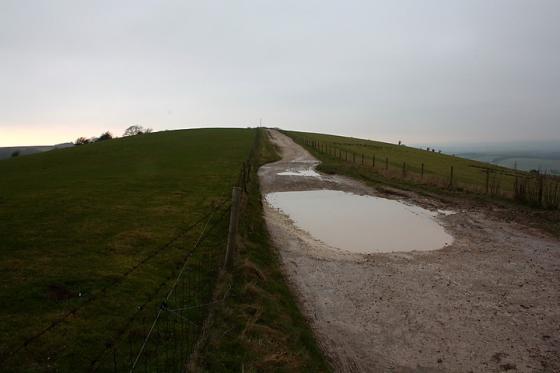Field Notes
Everleigh Barrow Group – SU 184561 – Sep 2007
Ordnance Survey Explorer Map 130 – Scale 1:25000
Salisbury & Stonehenge inc. Wilton & Market Lavington.
ISBN 978-0-319-23599-7
Visited this barrow group after seeing the Giants Grave Long Barrow, on Milton Hill.
I travelled up the B Road from Pewsey to Everleigh. Pewsey hill is very step and Pewsey’s White Horse looks down upon the valley from up here. It has numerous drovers’ tracks running up it from ancient times and the whole area is criss-crossed with byways and bridleways. All the traffic stopped using these routes when the military moved onto the Plain a hundred or so years ago. The tank training station at Tidworth lies just a few miles to the south and the area is accessible but very churned up.
This barrow group is on the edge of this training range, hence the Star of David signs to show it is an ancient monument and not to be dug into or driven over in a tank. The military have made great strides to prevent more damage to some of the ancient sites on the Plain, but some were already destroyed before they found their wisdom.
Once you have reached the top of Pewsey, travel along the flat plateau until you reach the track marked for Milton Hill Farm on the right and Down Farm on the left (SU 185570). If you intend to visit the Giants Grave Long Barrow, you would turn right for Milton Hill. I would suggest you find somewhere to park around the back of the farm and walk down the track to the barrow group.
The Everleigh barrows group are classified as the five barrow cluster at SU 184561.
I have included a map based on the SMR numbering for clarity.
Prefix the numbers with SU15NE i.e. SU15NE655, for search at https://history.wiltshire.gov.uk/smr/
Bowl Barrow (654) – Excavated by Hoare c1800 and again opened by Thurnam who found it to be unproductive. 13.5m diam x 0.3m high.
Bowl Barrow (655) – Flattened
Disc Barrow (656) – Excavated by Thurnam in the 19th century, who found it unproductive.
Mound Overall diam 59m, mound 0.3m high, ditch 0.7m deep, bank 0.5m high.
Bell Barrow (657) – Opened by Thurnam who found a primary cremation which was probably male and an intrusive extended, undated skeleton. Mound 81ft x 11ft, berm 18ft, ditch 15ft x 2.5ft. It is well-preserved and grass covered.
Dr. Thurnam writes, “The most eastern of the bell-shaped barrows is upwards of thirteen feet in elevation; and in this, in a slight cist scooped out of the chalk, was a large deposit of burnt bones, probably those of a man, unaccompanied by urn, weapons, or ornaments; and proving, as Sir Richard Hoare often found, that ” we must not judge of the contents by the form of a barrow. Fronti nulla fides.” The upper part had been used in later times for a secondary interment; the skeleton of a tall man being met with, about a foot from the summit, laid at full length and with the head to the south. The arms were close to the sides of the skeleton; the thigh bones measured nineteen and a half inches. The skull has an ovoid form, the crowns of the teeth are flatly eroded; and, notwithstanding the discovery of a few fragments of coarse Roman pottery close by, the interment may be attributed to the Anglo-Saxon period.”
Bell Barrow (658) – Opened by Thurnam who found a primary cremation with a flat axe-dagger. Mound Overall dima 50m x 3.2m high, with a 0.5m deep ditch.
Of this barrow Dr. Thurnam writes, “The more western barrow is not quite so high as the eastern. At the depth of about eleven and a half feet, was a heap of burnt bones, apparently those of a man; and with these a small bronze blade three inches in length, retaining one of the rivets by which it had been attached to its handle, and altogether similar to that figured at page 329 (W.A.M. Vol 6). Adjoining the burnt bones, was a pile of grey ashes mixed with wood charcoal.”
A short distance north-east of the barrows is a square earthwork enclosure of possibly iron age date. 800 metres north-cast of the barrows (SU 187567) is the Down Farm group of eight barrows, including a badly damaged bell-barrow. Although these barrows were dug by Colt Hoare around 1800, there is some doubt as to which barrows contained what objects. Most seem to have contained cremation burials, one with a bronze awl, shale beads and perhaps an incense cup.
A copy of John Thurnam’s 1860 notes, page 332, from the Wiltshire Archaeological Magazine Vol 6 is available to download in pdf format here
https://books.google.co.uk/books?id=DK0UAAAAYAAJ&printsec=frontcover&dq=editions:0CXB15IR7SUUL_bI&lr=&as_brr=1
Chance












































































































































































































